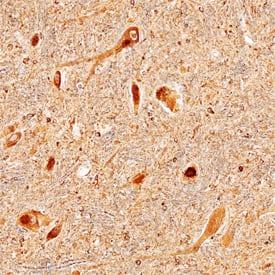Human LRRC4 Antibody
R&D Systems, part of Bio-Techne | Catalog # MAB49951

Key Product Details
Species Reactivity
Applications
Label
Antibody Source
Product Specifications
Immunogen
Ala39-Lys527
Accession # Q9HBW1
Specificity
Clonality
Host
Isotype
Scientific Data Images for Human LRRC4 Antibody
LRRC4 in Human Brain.
LRRC4 was detected in immersion fixed paraffin-embedded sections of human brain (medulla) using Mouse Anti-Human LRRC4 Monoclonal Antibody (Catalog # MAB49951) at 15 µg/mL overnight at 4 °C. Before incubation with the primary antibody, tissue was subjected to heat-induced epitope retrieval using Antigen Retrieval Reagent-Basic (Catalog # CTS013). Tissue was stained using the Anti-Mouse HRP-DAB Cell & Tissue Staining Kit (brown; Catalog # CTS002) and counterstained with hematoxylin (blue). Specific staining was localized to neuronal cell bodies, processes, and synaptic puncta. View our protocol for Chromogenic IHC Staining of Paraffin-embedded Tissue Sections.Applications for Human LRRC4 Antibody
Immunohistochemistry
Sample: Immersion fixed paraffin-embedded sections of human brain (medulla)
Formulation, Preparation, and Storage
Purification
Reconstitution
Formulation
Shipping
Stability & Storage
- 12 months from date of receipt, -20 to -70 °C as supplied.
- 1 month, 2 to 8 °C under sterile conditions after reconstitution.
- 6 months, -20 to -70 °C under sterile conditions after reconstitution.
Background: LRRC4
LRRC4 (Leucine rich repeat/LRR-containing protein 4), also called NGL-2 (netrin-G ligand-2) or NAG14 (nasopharyngeal carcinoma-associated gene 14) is a 55 kDa (predicted, unglycosylated) type I transmembrane protein that is a member of the NGL family of synaptic LRR adhesion molecules (1, 2). Human LRRC4 cDNA encodes 653 amino acids (aa) that include a 38 aa signal sequence, a 489 aa extracellular domain (ECD), a 21 aa transmembrane domain, and a 105 aa cytoplasmic domain. The ECD contains nine LRRs (aa 74‑288), a C2 type Ig like domain (aa 354‑440), and a Thr-rich segment (aa 455‑526). Within the ECD, human LRRC4 shares 98% aa identity with mouse and rat, 99% aa identity with canine and bovine, and 99.6% aa identity with equine LRRC4. It also shares 54‑55% aa identity with family members LRRC4C/NGL-1 and LRRC4B/NGL-3, but each recognizes different ligands (1). LRRC4 is predominantly expressed in the brain on neurons and astrocytes as a ligand for netrin-G2 on the dendritic surface of synaptic neurons (2-4). It is proposed to regulate the formation of excitatory synapses via recruitment of PSD-95 to the cytoplasmic domain after aggregation of LRRC4 at the surface (3, 5). It suppresses proliferation by downregulating cell signaling pathways, resulting in altered expression of cell cycle regulating proteins and delay at the late G1 phase (1, 2, 6-8). It is thus considered a tumor suppressor protein and is often downregulated in brain tumors, particularly gliomas (1, 2, 6). Forced expression of LRRC4 in tumor cells slows proliferation and promotes differentiation (1, 4, 9). Addition of soluble LRRC4 to cultured neurons reduces excitatory synapse formation (3).
References
- Woo, J. et al. (2009) Mol. Cell. Neurosci. 42:1.
- Zhang, Q. et al. (2005) FEBS Lett. 579:3674.
- Kim, S. et al. (2006) Nat. Neurosci. 9:1294.
- Wu, M. et al. (2007) Acta Biochim Biophys Sin (Shanghai) 39:731.
- Nishimura-Akiyoshi, S. et al. (2007) Proc. Natl. Acad. Sci. USA 104:14801.
- Wu, M. et al. (2006) Mol. Biol. Cell 17:3534.
- Wu, M. et al. (2008) J. Cell. Biochem. 103:245.
- Wu, M. et al. (2008) J. Cell. Physiol. 214:65.
- Zhang, W. et al. (2008) Genes Brain Behav. 7:385.
Long Name
Alternate Names
Gene Symbol
UniProt
Additional LRRC4 Products
Product Documents for Human LRRC4 Antibody
Product Specific Notices for Human LRRC4 Antibody
For research use only
